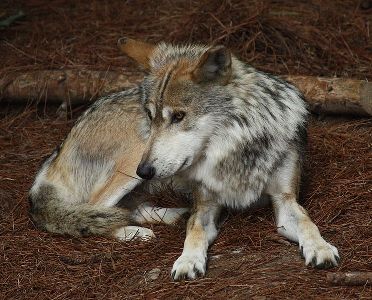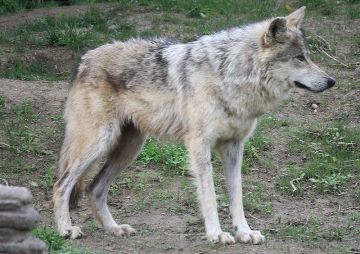Press Release: Study: 90 Percent of Endangered Species Recovering on Time
For Immediate Release, May 17, 2012
Contact: Tierra Curry, (928) 522-3681
 WASHINGTON— A new Center for Biological Diversity analysis of 110 endangered species finds that 90 percent, including many in the Southwest, are on track to meet recovery goals set by federal scientists. The review examined population trends of plants and animals protected by the Endangered Species Act in all 50 states, including the Southwest’s Gila trout, Apache trout, gray wolves and California condors. Again and again, the analysis finds species on a positive trajectory toward recovery — and in some cases, exceeding expectations.
WASHINGTON— A new Center for Biological Diversity analysis of 110 endangered species finds that 90 percent, including many in the Southwest, are on track to meet recovery goals set by federal scientists. The review examined population trends of plants and animals protected by the Endangered Species Act in all 50 states, including the Southwest’s Gila trout, Apache trout, gray wolves and California condors. Again and again, the analysis finds species on a positive trajectory toward recovery — and in some cases, exceeding expectations.
“There are Endangered Species Act success stories in every part of America, and the Southwest is no exception,” said Kieran Suckling, executive director of the Center. “No other law in the world has done so much to rescue species from the brink of extinction and put them on a path to recovery. Simply put, the Act has been remarkably successful.”
The study analyzed population data for 110 species from the year each was placed on the endangered species list through 2011. Each species’ actual population trend and trajectory was compared to the timeline for recovery set out in government recovery plans. Nearly all the animals and plants are recovering on time to meet federal goals.
The study’s findings are similar to a 2006 Center analysis of all federally protected species in the Northeast, which found 93 percent were stabilized or improving since being put on the endangered species list and 82 percent were on pace to meet recovery goals.
“Some of the Southwest’s signature species, from gray wolves to Apache trout, are on their way to recovery thanks to the Endangered Species Act,” Suckling said.
Today’s report, which relies on data from the U.S. Fish and Wildlife Service and independent scientists, is a science-based rebuttal to attacks on the Act by critics like Rep. Doc Hastings (R-Wash.), chairman of the U.S. House Committee on Natural Resources, who claims the Act is “failing badly” because only 1 percent of species have been recovered. In fact, the report finds that 80 percent of species haven’t been listed for long enough to reach their projected delisting date. On average, species have been protected for 32 years and have a typical expected recovery period of 46 years.
“Saving species from the brink of extinction — and bringing them back to a point where they’re going to survive into the future — can’t happen overnight,” Suckling said. “Calling the Act at failure at this point is like throwing away a 10-day prescription of antibiotics on the third day and saying they don’t work. It just makes no sense.”
For full recovery profiles of the 110 species — and an interactive regional map — go to www.ESAsuccess.org.
Southwest Highlights
Apache trout. This golden, black-spotted trout, one of only two trout species native to Arizona, is the state fish. By 1940, overfishing, habitat degradation and nonnative trout stocking had reduced the miles of stream habitat it occupied from 600 to 30. Listed as endangered in 1969, the trout’s early recovery efforts were led by two Apache tribes that banned sportfishing on some streams and began a captive-propagation program. Since 1983, a national fish hatchery on the Fort Apache reservation has produced several million Apache trout. Beginning in the 1980s, livestock were excluded from streams, and 100 miles of stream on U.S. Forest Service lands were fenced to restore Apache trout habitat. The species was downlisted from “endangered” to “threatened” in 1975. In 2010 there were 32 populations of Apache trout, 29 of which were identified as self-sustaining, which is approaching the recovery criteria of 30 self-sustaining populations.
Utah prairie dog. The smallest of the five North American prairie dog species, these foot-tall members of the squirrel family formerly occurred on 448,000 acres in southwest Utah. Poisoning campaigns by ranchers and the federal government began in the 1880s, and throughout the 1920s and 1930s tens of thousands of acres were treated with poison each year. By 1972 those efforts, along with habitat loss caused by livestock and agriculture, sylvatic plague and drought, had reduced its population to just 3,300 individuals. In 1973 the species was listed as endangered and began improving almost immediately. The population was estimated at 9,332 individuals by 1981, and the species was downlisted to threatened in 1984. Since then the population has experienced short-term upward and downward trends, but has increased overall. By 2010 the estimated population had risen to 11,296.
 Gray wolf, southwestern population. In 1970, after being hunted to near extinction for the protection of cattle, the last Mexican gray wolf was shot in Texas, and the subspecies was extirpated from the United States. At that time, no wolves were present in what is now delineated as the range of the southwestern population: southern New Mexico, southern Arizona and western Texas. The Mexican gray wolf was placed on the endangered species list in 1976 and the last five wild wolves from Mexico were captured and moved to captive-breeding facilities. In 1998, after conservationists had filed suit to force the reintroduction of the wolves, the first 11 captive Mexican gray wolves were released in Arizona, near the New Mexico border. By the end of 2011, there were an estimated 58 wild wolves, including six breeding pairs. In 2010, the total number of captive and wild wolves was 333.
Gray wolf, southwestern population. In 1970, after being hunted to near extinction for the protection of cattle, the last Mexican gray wolf was shot in Texas, and the subspecies was extirpated from the United States. At that time, no wolves were present in what is now delineated as the range of the southwestern population: southern New Mexico, southern Arizona and western Texas. The Mexican gray wolf was placed on the endangered species list in 1976 and the last five wild wolves from Mexico were captured and moved to captive-breeding facilities. In 1998, after conservationists had filed suit to force the reintroduction of the wolves, the first 11 captive Mexican gray wolves were released in Arizona, near the New Mexico border. By the end of 2011, there were an estimated 58 wild wolves, including six breeding pairs. In 2010, the total number of captive and wild wolves was 333.
Black-footed ferret. This 2-foot-long, black-masked member of the weasel family once occurred in central grasslands and basins from southern Canada to Texas but is now one of the most endangered mammals in North America. In the early 1900s, the United States was likely home to more than 5 million ferrets. But ferrets, which hunt prairie dogs for food and live in their burrows, were almost wiped out early in the 20th century after agricultural development and rodent poisons devastated prairie dog populations. Thirteen years after they were listed as endangered in 1967, the last captive ferret died, and the animals were thought to be extinct in North America. Then in 1981 a small relic population was discovered in a Wyoming prairie dog colony. Between 1991 and 1999, about 1,200 ferrets from that population were released in Wyoming, Montana, South Dakota, Arizona and along the Utah/Colorado border. At least two of those reintroduced populations are established and no longer require releases of captive-raised ferrets. Biologists estimate there are now a total of about 700 black-footed ferrets living in the wild.
California condor. With a wingspan of almost 10 feet, California condors are one of the world’s most striking flying birds. Decimated by DDT, lead poisoning, shooting and collection, the U.S. population dropped to just 40; it was listed as endangered in 1967. By 1985, their numbers had dropped to just nine; two years later all remaining birds were taken into a captive-breeding program. By 2011, the population had grown to 396 birds ranging across three wild populations, from the mountains north of the Los Angeles basin and the Big Sur area of the central California coast to the Grand Canyon area of Arizona. Poisoning from lead ammunition is the primary factor now limiting condor recovery.
Gila trout. By 1950 competition with nonnative fish and habitat degradation caused by mining, logging and cattle grazing had reduced this iridescent gold and profusely spotted trout to about 20 stream miles in New Mexico. A 1975 survey conducted eight years after the fish was first listed as endangered found that only five populations remained in the upper Gila River drainage. By 1987 recovery and reintroduction efforts had resulted in the establishment of Gila trout populations at eight locations in New Mexico and one in Arizona, with the total population estimated at more than 18,000. Despite setbacks caused by flooding, fire and drought, by 1998 ongoing captive-propagation and reintroduction efforts had pushed the wild population up to around 37,000. By 2003 there were 14 populations of Gila trout that inhabited 65 miles of habitat. Three years later, the fish were downlisted, and some recreational fishing was allowed.
###
Photos of Mexican gray wolves in captivity courtesy of Trisha Shears



